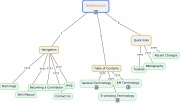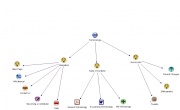Mind Mapping
From Learning and training wiki
| A Learning methodology that consists of drawing diagrams used to represent words, ideas, tasks, processes or other items. It is a non-linear way of organizing information and a technique that allows to capture the natural flow of ideas. Each idea or fact is written down and then linked by lines or curves to its major or minor (or following or previous) idea or fact, thus creating a web of relationships. Its purpose is to focus attention, and to capture and frame knowledge to facilitate sharing of ideas and concepts.
Mind maps can be used to:
|
| In the table below there is a list of mindmapping tools. All of them are free-sources. You will also find some basic information about them, like if they are downoladable or only usable on-line, what kind of features and which degree of freedom in constructing the map they offer. By clicking the visualization image you will be able to see a sample map. |
| Tools | Downloadable/on-line | Special Features | Structure | Visualization |
|---|---|---|---|---|
| Freemind | To download (10.4 MB) | Link to files and web-sites | Ramification only horizontal. No freedom to change the structure. | |
| CMAP Tools | To downlad | Link to files and web-sites | Free structure. Every arrow connecting two nodes is supposed to contain a label | |
| Mindmeister | On-line application. Avaiable in two verison: Basic for free, Premium to pay (4$ per month) | Link to files and web-sites | Ramification only horizontal. No freedom to change the structure. | |
| Bubbl.us | On-line application | Link to web-sites, impossible to link files | Free structure | |
| VUE | To download | Link to files and web-sites | Free structure. Possibility two add a label on the connection between two nodes. | |
| Compendium | To download | Link to files and web-sites | Free structure. Every node has to belong to a cathegory (question, decision, argument, idea..) | |
| Wisemapping | On-line application | Link to web-sites, impossible to link files | Ramification only horizontal. No freedom to change the structure. | |
| Mind42 | On-line application | Link to web-sites, impossible to link files | Ramification only horizontal. No freedom to change the structure. |
References
- ↑ astd-cac.net (08 July 2008) Wikipedia(08 July 2008) www.mind-mapping.co.uk (08 July 2008), www.illumine.co.uk (08 July 2008), www.mindtools.com (08 July 2008), www.thinksmart.com (8 October 2008), www.mindtools.com (8 October 2008), www.businessdictionary.com (8 October 2008)





